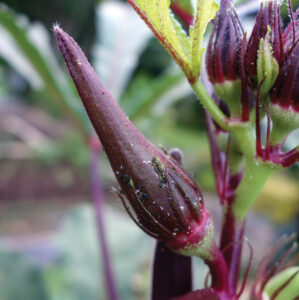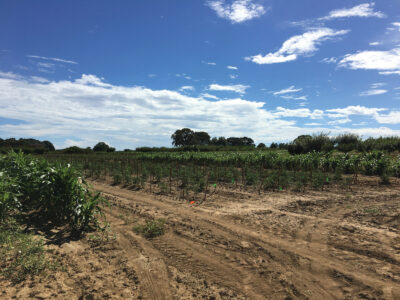My Kentucky garden has stink bugs, leaf-footed bugs, and aphids. These insects have also been spotted in entomologist Ayanava Majumdar’s research gardens in India, North Dakota, and Alabama, and wherever you are, they’re probably in your garden too. They’re among the most devastating pests for anyone growing food, and farmers and gardeners have gone to great lengths to keep them from destroying plants.
If these and other insects plague your growing season, you’ve likely spent considerable time, effort, and expense trying to eradicate them. This year, when you’re planning your defense strategy, consider planting a few extra plants for insect pests to munch on. It may not seem like the obvious solution to the problem, but this type of well-laid “trap” might be just the thing your garden needs.

Developing Decoys
Majumdar – known to his students at Auburn University as “Dr. A” – first studied and worked in entomology in Uttarakhand, India. When he moved to North Dakota for his doctorate and then to Alabama for his work with the Alabama Cooperative Extension System, he found that many insects have a global reach.
“The U.S. has the same insect spectrum as in India, just the timing is different because the crops are different,” says Majumdar, who’s in his 10th year as a state coordinator for the Sustainable Agriculture Research and Education program. “In the tropics, there are more generations of insects to deal with. Here, we are blessed with a killing cold, and that helps a lot.”
Majumdar has been working to combat these insect pests with an integrated pest-management system, for both environmental and financial concerns. So far, he’s concentrated on high-value specialty crops, including tomatoes, corn, squash, and watermelon. During his trials, Majumdar and his students began using trap crops – a technique in which one type of crop (the trap) is grown solely to lure pests away from another type of crop (the main crop) – and discovered that they work quite well. Trap crops are a type of companion planting, but instead of planting tomatoes with basil because it makes the tomatoes taste better, you’d plant sorghum a few rows away from your tomatoes because it’ll draw away leaf-footed bugs.
“We were doing work on stink bugs and leaf-footed bugs, because those sucking insect pests are some of the toughest insects you can find,” Majumdar says. “We were looking at controlling them with a trap crop in orchards, but we ended up developing the system much more rapidly in the vegetable system. Now, we have almost seven years of data with different crops.”

Trap crops have made such an impact on his pest-control system that Majumdar now works them into every crop he plants in his research plots. “You have to plan these things into your management system,” he says. “It’s not an afterthought. The trap crop is so important for us that we actually delay our main crop planting until we have a trap crop. The benefits of it are tremendous toward the middle to end of the season.”
Bagging Additional Benefits
While distracting insects away from vegetables is the main goal of using trap crops, Majumdar has found that the plants offer additional benefits as well.
“They provide a unique environment to pollinators and beneficial insects, because it’s a reduced-spray system,” he says. “Whether you’re organic or conventional, your overall spray needs should go down.”
Still, some spraying is a component of using trap crops effectively, especially when you first establish the system and large populations of pest insects gather in your garden. When the insects congregate as nymphs on a trap crop, you can use botanical insecticides to prevent them from feeding and reproducing.
Majumdar says it’s not uncommon for him to spray bioinsecticides weekly in his Alabama research gardens to produce a usable crop. When he employs trap crops, however, he doesn’t spray as often, and he estimates saving more than $100 per acre on bioinsecticides. The savings could be even greater in places with less pest pressure.

The beneficial plant and insect life that trap crops bring to a garden is another bonus. Majumdar has found that the longer he uses trap crops, the less he needs to spray for pests, because beneficial insects take care of them instead. Trap crops can offer shelter, food, and reproductive space to beneficial insects, and the high population of their favorite food – pest insects – is also a draw.
Beyond increased biodiversity, trap crops can also suppress weeds and offer protection from the elements. “In the case of sorghum and sunflower, I’ve also seen suppression of weeds on the perimeters,” Majumdar says. “The sorghum actually smothers the weeds. And also wind protection; so if you are a small farmer, say you have an acre of land and you do a perimeter trap crop with the sorghum and sunflower, you can get some wind reduction, and it protects your plants in the middle.”
Strategize Your Snares
Trap crops aren’t a fix-all, of course, and the system can have its challenges. One downside to using trap crops is the need to buy or find additional seed. For example, some seeds aren’t widely available, so sourcing them can be tricky. This happened to Majumdar and his students during trials with ‘NK300’ sorghum, which was a favorite of leaf-footed bugs but wasn’t easy to find.
Another consideration is the importance of getting your plant layout correct. “You can’t just drop the seed anywhere and expect miracles to happen,” Majumdar says. “You have to design the system.”

When you plant a trap crop, you’re purposely attracting insects to one area of your garden or field. If not done properly, those insects can discover your main crop before they make it to your trap crop. “You have to know where they are coming from,” Majumdar explains. “There is a strong directional effect.”
Majumdar says he thinks of trap crops like walls. If your garden is bordered on one side by an orchard, for example, you can be sure insects will come from that direction, and that side may be the best place for your trap crop barrier. Other situations may call for a trap crop perimeter around the whole garden or field, or trap crops interspersed between crop rows.
Incorporating trap crops successfully comes with a learning curve, but Majumdar says many farmers are motivated enough by their first-season results to continue using the system.
Plant Traps on Your Property

Small- to medium-sized farms are where Majumdar has seen the most success with trap crops. Here are a few tips for using the system in your own growing space.
- Plan to dedicate 10 to 15 percent of your garden or field to trap crops.
- Plant your trap crop two weeks before your main crop. This way, the trap crop will be established enough to distract pests while your main crop is in its most fragile stage.
- Consider harvesting your main crop early when possible, while the insects are still distracted by your trap crop. Succession plant trap crops when growing them alongside main crops that have a long season.
- Plant your trap crop near your main crop, but not too close. In the case of a sorghum-sunflower mix to control tomato pests, plant it 6 to 10 feet away from the main crop.
- Trap crops aren’t well-suited for use inside high tunnels, because they take up valuable space and can limit airflow, which promotes disease. If you want the beneficial effects of trap crops within your high tunnel, try planting them just outside instead.
- Don’t lean on trap crops exclusively. They should make up one part of your holistic pest-control plan. Plant selection, timing, and other means of attracting beneficial insects to your property will play a role in how well your trap crop system works.
- Understand your pest insects, their life cycles, and their plant preferences to best target them.
Majumdar sometimes gets asked whether he has one crop that can solve all insect problems. “I wish” is his response. Research is still ongoing about trap crops, but here are a few plants he and other researchers have had success with.
‘Blue Hubbard’ squash can keep squash bugs and cucumber beetles from other cucurbits, including watermelon, cantaloupe, and cucumbers. ‘Blue Hubbard’ plants and fruits are large, hardy, and fast-growing. If your insect infestation is mild enough, you may have an edible, or even marketable, crop at the end of the season.

Hot cherry peppers will lure pepper maggots away from bell peppers.
A sorghum-sunflower combo can be an effective trap crop for tomatoes. Leaf-footed bug adults are attracted to sorghum panicles and sunflower seeds.
Research from Pakistan published in the International Journal of Academic Management Science Research suggests that wheat can be used to draw thrips away from onions. It outperformed carrots and tomatoes during research trials.
‘Purple Top White Globe’ turnips can keep yellow margined leaf beetles from damaging cabbage.
Harlequin bugs prefer mustard greens over collard greens.
While not part of an official research project, Majumdar notes that aphids and stink bugs are attracted to okra. In fact, planting okra near a trap crop setup can draw insects away from the trap crop.
With all there is to consider in planning a trap crop system, the best advice for beginners is to start small and seek help. The last thing you want is to invite swarms of insects to your garden and then not know what to do with them. Once you learn how to best implement the system in your growing spaces and how to incorporate it with other pest-control strategies, you’ll reap the rewards of well-laid traps for seasons to come.

Trap Crop Resources
The Alabama Cooperative Extension System offers a Farming Basics mobile app that’s ideal for on-the-go learning. It also offers an online “Farming Basics” course to help identify insect pests, and its website has links to videos explaining trap crops and other farm and garden topics. Visit the “Farming” page for free resources of all kinds, including a slide chart about pests and how to manage them. (Search “Home and Market Garden [Urban Farm] IPM Toolkit.”)
Visit with your local extension agent. If they aren’t knowledgeable about trap crops, they’ll likely know someone who is.
Contact your state’s Sustainable Agriculture Research and Education coordinator. They’ll know the professionals in your state who have the knowledge to help you design a trap crop system on your property.

Lisa Munniksma is a farmer, editor, and freelance writer who lives in Kentucky.